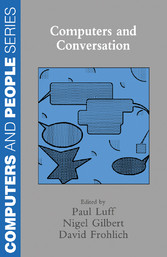Suchen und Finden
Service

Computers and Conversation
Paul Luff, David Frohlich, Nigel G. Gilbert
Verlag Elsevier Reference Monographs, 2014
ISBN 9780080502649 , 293 Seiten
Format PDF
Kopierschutz DRM
Front Cover
1
Computers and Conversation
4
Copyright Page
5
Table of Contents
8
List of Contributors
6
Introduction
10
Acknowledgements
14
Chapter 1. On the Analysis of Interaction: An Introduction to Conversation Analysis
16
1.1 Introduction
16
1.2 Harvey Sacks: 'order at all points'
19
1.3 The inferential character of ordinary talk
22
1.4 The structure of conversational organisation
29
1.5 Social organisation and social interaction
36
1.6 The methodology of conversation analysis
43
1.7 Conclusion
46
Acknowledgements
47
Chapter 2. Towards a Sociology of Human-Computer Interaction: A Software Engineer's Perspective
48
2.1 Introduction
48
2.2 The nature of software engineering
49
2.3 The nature of HCI
51
2.4 A sociology of interaction for software engineering
53
2.5 Making progress
57
Acknowledgements
58
Chapter 3. The Very Idea: Informing HCI Design from
Chapter 3. The Very Idea: Informing HCI Design from
60
60
3.1 Introduction
60
3.2 Human-computer interaction
61
3.3 Conversation analysis and human-computer interaction
63
3.4 Informing HCI design from Conversation Analysis: an example
67
3.5 The applicability of Conversation Analysis to HCI
70
3.6 Guidelines for the designer
72
3.7 Conclusion
73
Chapter 4. Going Up a Blind Alley: Conflating Conversation Analysis and
Chapter 4. Going Up a Blind Alley: Conflating Conversation Analysis and
76
76
4.1 Introduction
76
4.2 Conversation and rules
79
4.3 The status of rules in the description of human action
85
4.4 Conclusion
98
Chapter 5. Communicative Action and Computers: Re-embodying Conversation
Chapter 5. Communicative Action and Computers: Re-embodying Conversation
100
100
5.1 Introduction
100
5.2 Background partners?
103
5.3 Some possible directions: courtship
109
5.4 Empirical investigation of situated dialogue
119
5.5 Conclusions
131
Appendix
135
Acknowledgements
141
Chapter 6.
Chapter 6.
142
142
6.1 Introduction
142
6.2 Slips, schizophrenia and everyday conversation
144
6.3 An extended repair sequence
146
6.4 Relevance to the study of ordinary conversation
149
6.5 Conclusion
154
Appendix
156
Chapter 7. Repair Work in Human-Computer Interaction: A Conversation Analytic Perspective
160
7.1 Introduction
160
7.2 Two perspectives on repair work
161
7.3 Choosing and implementing the domain for the study
168
7.4 Evaluation
170
7.5 Conclusions
179
Acknowledgements
180
Chapter 8.
Chapter 8.
182
182
8.1 Introduction
182
8.2 Why conversation?
184
8.3 Example
185
8.4 Dialogue analysis
186
8.5 Conversation analysis
191
8.6 Automated support
194
8.7 Observational studies
194
8.8 Conclusion
195
Acknowledgements
195
Chapter 9.
Chapter 9.
196
196
9.1 Introduction
196
9.2 The Advice System
198
9.3 Dialogue control requirements
200
9.4 Selecting a CA approach to dialogue control
203
9.5 Dialogue control policies
208
9.6 Conclusions
227
Acknowledgements
229
Chapter 10. A Computational Model of Explanatory Discourse: Local Interactions in a Plan-Based
Chapter 10. A Computational Model of Explanatory Discourse: Local Interactions in a Plan-Based
230
230
10.1 Introduction
230
10.2 Structuring interactions within plan-based explanations
232
10.3 Local coherence and repair
240
10.4 Conclusion
242
Acknowledgements
243
Chapter 11.
Chapter 11.
244
244
11.1 Introduction
244
11.2 The architecture of a speech understanding system
246
11.3 Adjacency pairs: a central feature of conversational organisation
248
11.4. Arguments against a computational approach to conversational phenomena
250
11.5 A computational approach
254
11.6 The arguments reconsidered
262
11.7 Conclusion
265
Acknowledgments
266
Notes on Transcription Conventions
268
1 Talk
268
2 Special conventions: gaze, keyboard and gesture
270
References
272
Index
290


